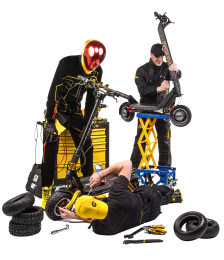Accurate and exact data
Independent testing of electric scooters
We take testing seriously and achieve very accurate results
We are a world leader in accurate independent scooter tests. However, we are not doing it to be a No. 1 but rather so that our customers have accurate and exact data available to make a responsible decision. This is only possible on the basis of real measured data and not on the basis of marketing claims made by manufacturers.
- We verify manufacturers' claims.
- Internal methodology and exact results.
- Scientific approach and multiple test runs.
- Highly accurate measurement utilizing professional instruments.
- With our tests, you are able to compare scooters made by various manufacturers that were subjected to identical tests.
- We have become a world leader in such accurate independent testing.
Measured parameters
Acceleration Learn more about acceleration
We also measure its time sequence, available in the chart.
Braking distance Learn more about braking distance
Its time sequence, time and distance required for braking.
Range Learn more about range
We verify the claims made by manufacturers regarding maximum range (at 20 km/h and with a 80 kg rider).
City cycle range Learn more about city cycle range
Our own independent test requiring the scooter to stop to a halt every 100 meters and accelerate again.
Weight Learn more about weight
Accurate weight measurement of a scooter, as delivered to the customer.
Test procedures
We perform all tests with a rider weighing 80 kg, including clothing (wearing extra load, if necessary). The scooters are always in their default condition, as delivered to customers and without any accessories or modifications, unless included. We perform all tests with a fully charged battery. The only modification done to the scooter is the attachment of a special measuring device weighing 130 g. See below for more information about the used hardware and methodology. Where the measured vehicle comes with air-filled tires, they are inflated to medium pressure recommended by the manufacturer.
At start, the rider uses his foot to mildly push off the scooter, similarly to normal riding. This measure is necessary because of models that can not have their kick-start feature turned off. In order not to put at disadvantage the models with kick-start feature switched off, the rider performs this first kick with these models as well.

Top speed
The top speed is measured by us with high accuracy and while riding on a level surface. The speed is always an average of values measured in two independent measurements in the opposite travel direction, while we consider the top speed to be the highest speed maintained for a period of at least 10 seconds in each test direction. The result comes as the average of these values. By doing so, we eliminate any wind impact and also any inclination of the test track.
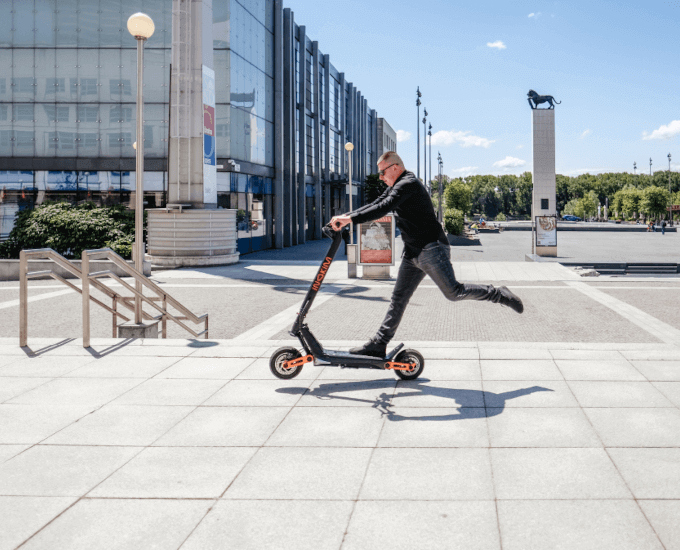
Acceleration
As a rule, we measure acceleration from two points of view, both of which are being used in the motoring and motor sports. Those are measurements based on speed over time and distance over time. The results come always as the average of two separate measurement runs along the same route but in opposite direction. The exact measurement methodology is provided below.
Speed over time
When measuring speed over time, we measure acceleration time between any two speed values ranging between (in km/h) 0, 10, 15, 20, 25, 30, 40, 50, 60, 70, 80, 90, 100.
Therefore, at our disposal is the acceleration from 0 to 25 km/h, as well as from 10 to 20 km/h. Where the scooter is unable to reach any of these speeds, this measurement is not specified in the interest of preserving measurement transparency.
Distance over time
The second method of looking at acceleration is the time necessary for reaching certain distance from zero initial speed. The advantage of this method is that it is also a function of the scooter's top speed and how fast it achieves it. This method is known from motor sports, the so-called drag racing.
We measure time necessary for reaching the following distances from zero initial speed (in meters): 100, 250 and 1000.
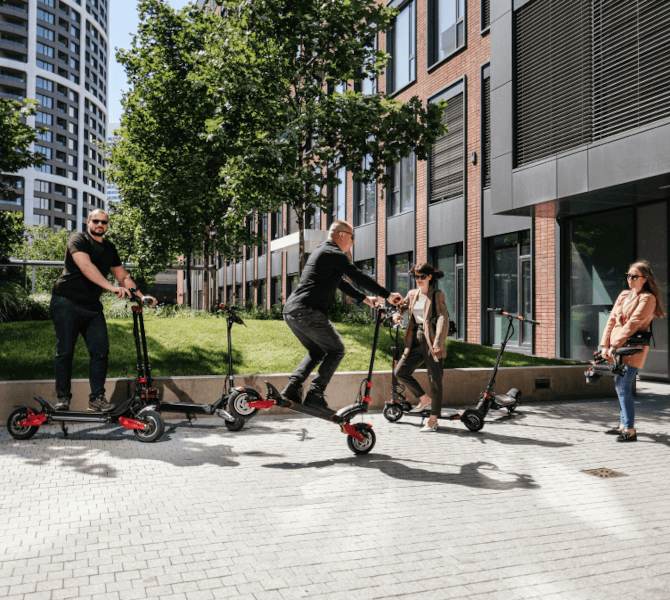
Braking distance
We measure braking distance by braking abruptly from the scooter's top speed. The indicated result comes always as an average of two independent measurements in opposite direction, with the brakes being allowed to cool down between the test runs. This means that the measurement takes place as if it involved emergency braking with cold brakes.
We always indicate braking distances by time and meters necessary to stop the scooter fully from the following initial speeds: 10, 15, 20, 25, 30, 40, 50, 60, 70, 80, 90, 100 km/h. Where the scooter is unable to reach any of these speeds, this measurement is not specified in the interest of preserving measurement transparency.
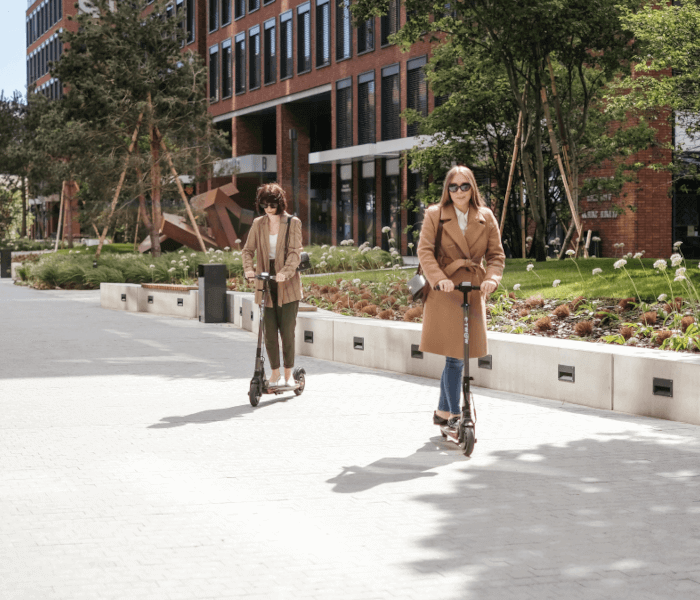
Maximum range
The maximum range measurement verifies the data provided by manufacturers. This is not a range that would be close to real-world range as it usually represents a range with no wind, at a constant speed of 20 km/h, on a flat surface and with a rider weighing 80 kg. All manufacturers have their own and slightly different methodology and they attempt to provide the highest possible number. In reality, however, no one rides like that. But since other vendors stick to this parameter, we decided to add this test while ensuring fair and uniform conditions for all manufacturers and models.
Who stands on the scooter?
We decided for a rider weighing 80 kg (with added weight, if necessary) and to make the testing fair and exclude any wind influence or any incline of the road (even if minimal), the test uses a 2 km long section, at the end of which the rider stops at a distance of 10 m and starts moving in the opposite direction. The rider stops accelerating when the GPS device shows that he has reached 20 km/h, disregarding the built-in speedometer that tends to be inaccurate with many scooter models.
Test end
We consider the test ended when either the battery is completely discharged or when the scooter is no longer able to maintain a speed of at least 5 km/h. The total distance traveled during this test is then deemed to represent the scooter's maximum range.
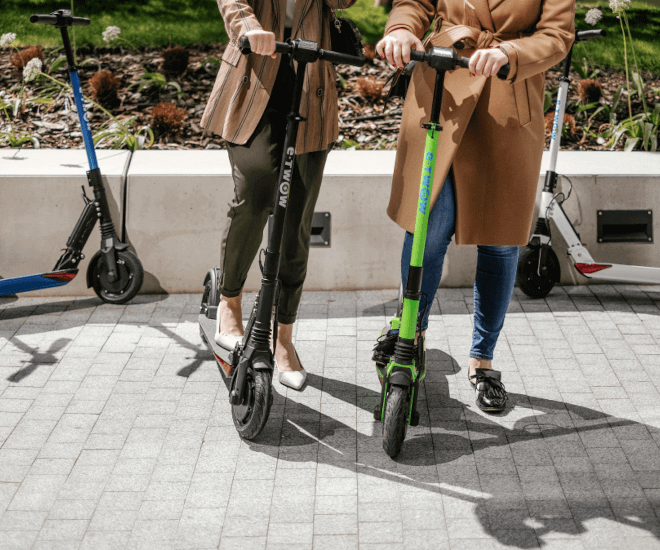
City cycle range
This range figure is closer to the real use of a scooter in a city. Since there is nobody in the world yet with a default methodology and nobody performs measurements like we do, there is no official standard for measuring the range of personal electromobility devices. That is why we introduced our own standard, after carefully considering the methodology.
The acceleration from 0 to 20 km/h (according to GPS) takes place based on scooter's capabilities. Once 20 km/h is established, the rider maintains a speed close to 20 km/h until reaching a 90 m distance from the starting point. He then brakes over a distance of 10 m exactly, reaching a total distance of 100 m. He turns in opposite direction and continues the cycle.
Who stands on the scooter?
We decided for a rider weighing 80 kg (with added weight, if necessary) and to make the tests fair and exclude any wind influence or any minimum incline of the road, the test uses 100 m long sections in opposite direction.
Test end
We consider the test ended when either the battery is completely discharged or when the scooter is no longer able to maintain a speed of at least 5 km/h. The total distance traveled during the test is considered the scooter's maximum city cycle range.
We are aware that every city is different, every rider is different and has a different style, plus his/her route has different inclination. But since we must remain objective, we needed a transparent and always repeatable test. We came with 100 m distance by analyzing dozens of common routes in various cities, featuring traffic lights, intersections, pedestrian crossings, as well as bicycle routes. Yes, there are people who may have an average distance of 300 m between individual stops, but they still have to brake from time to time or may have a mild slope along their route. Our test is designed to test the average range on an average route of an average rider.
It does not guarantee that you will achieve the same range. But it allows you to compare different scooters, and this not based on any manufacturer claim (made after performing a meaningless constant speed test) but based on an objective and fair testing taking place under identical conditions and performed by an independent vendor.
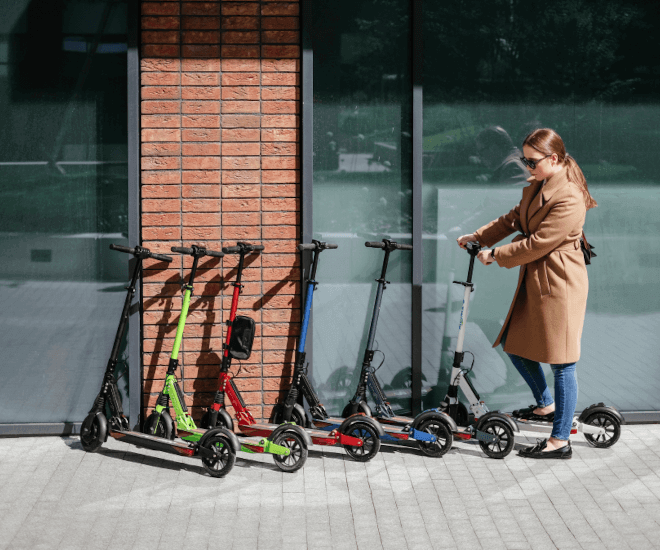
Weight
We measure weight using an accurate hanging scale providing 50-gram accuracy. We chose this scale type because of its weighing simplicity eliminating any likely errors and allowing us to weigh even the heaviest and largest electric scooters. We always weigh the scooters as supplied by the manufacturer, ready to ride and without any charger.
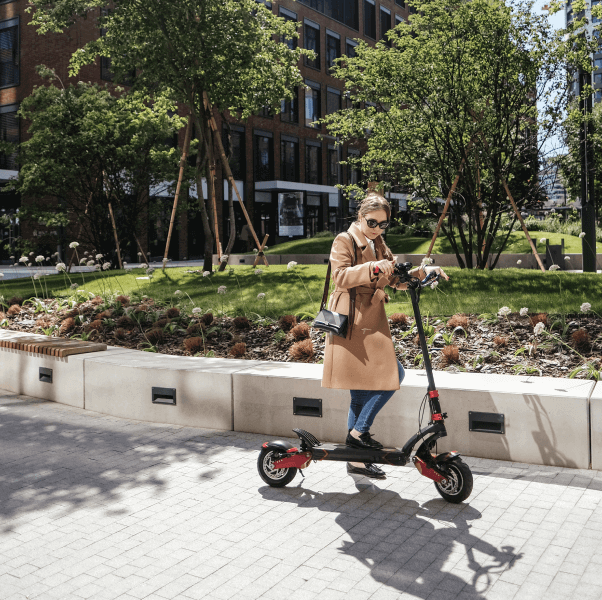
Power
The performance test is one of the most challenging tests. Given the fact that personal electromobility devices are very different, there is presently no simple way of measuring their power, unlike brakes that are used to measure performance of cars. However, these brakes too measure the net power on the wheels and then estimates are used to determine losses due to internal resistances of car components. We are mostly interested in verifying the parameters claimed by manufacturers, which means that we are interested in the net engine power. For this reason, it is not enough to measure just the on-wheel power (or on-wheels in case of 2x2 scooters), but it is also necessary to take into account the rolling resistance, internal resistances of scooter's bearings, possible road inclination and, at higher speeds, also the air resistance that increases quadratically and its impact on measurement thus grows sharply at higher speeds.
In this way, we can calculate the power quite accurately, but it is not net power since a large portion of this power is consumed, for instance to overcome air resistance, rolling resistances and the like. However, since we are interested in the real power of the engine(s), meaning its full power, including power not leading directly to acceleration, we only need to calculate the power consumed to overcome all other resistances combined, in particular air resistance, rolling resistance and internal resistances. We can measure those resistances using the same methods, namely by measuring the scooter's deceleration from its top speed to zero without using a motor.
By accurately measuring the scooter's deceleration from its top speed, we can calculate the power and its time sequence used to overcome all resistances combined (internal resistances, rolling resistance, air resistance…). This power used to overcome those resistances can be then simply added to the net power used for the acceleration itself. And that is - total power of the engine(s). These precise measurements allow us not only to verify the claims by manufacturers about the power produced by the used engines, but in particular to establish a method to objectively compare these outputs or monitor their time sequence, and this even between different brands and models. Because even if our measurements introduce a certain measurement error, they introduce it equally with all scooters and the comparison of their performances is therefore quite accurate and objective.
Measurement advantageAnother advantage of our independent measurements is the ability to look not only at the peak power of the motor, but also at its time sequence depending on the scooter speed.
Principle of the above
calculation
One possible way of expressing power is to multiply speed by force. The resistance forces act on the vehicle while it is moving. The product of the speed and the corresponding resistance force at a given moment equals the instantaneous engine power.
By measurement, we establish the vehicle's speed sequence over time at maximum acceleration. This gives us the first input variable.
Using other measurement, we determine the speed sequence over time during spontaneous deceleration of the vehicle (from top speed at idle until it stops). From these values, it is possible to determine the approximation function of speed with respect to time. The law of force (Newton's second law) defines force as a product of mass and acceleration. We obtain the time sequence of acceleration values (in this case "deceleration") of the vehicle by the first derivative of the aforementioned speed function with respect to time. The vehicle's weight is known, which means we are able to establish the force of ambient resistance and internal resistances of the vehicle for each time point of measurement. Subsequently, we determine the equivalent function of the environment's resistive force and internal resistances with respect to vehicle speed.
As in the previous case, the law of force applies when the vehicle accelerates. We once again establish the time sequence of vehicle acceleration by deriving the vehicle speed function during acceleration with respect to time. We multiply the obtained acceleration by weight. The total resistance force during vehicle movement is the sum of the aforementioned ambient resistance force and the internal resistance of the vehicle, plus the acceleration resistance of the vehicle.
Finally, we multiply the total resistance force by speed and establish power at a given time.
The above measurements and calculations do not allow determination of individual resistance coefficients or parameters, such as gear ratio or vehicle's cross-sectional area, but their effect is defined by the function of riding resistances, the output of which is applied in the calculation. This eliminates the need to introduce constants that are commonly used when calculating riding dynamics.
MathematicsCalculation principle - relations
Below we provide the relations and methods used in power calculation from the time sequence of acceleration and subsequent
deceleration. Some math is needed, but it is not a rocket science.
- Power: P = W / t
- Work: W = F * s
-
Of which: P = F * s / t, where "s / t" can be replaced with: v = s / t, where “v” is velocity.
After substitution: Pvx = Fvx * vx, i.e. Pvx power corresponding to vx velocity equals the product of vx velocity and Fvx resistance force corresponding to vx velocity. If the force acting on the vehicle is greater than the constant speed resistances, then the vehicle is accelerating. The Fvx force has two components – ambient resistance (rolling resistance, air resistance, incline resistance) and internal vehicle resistance (resistances in the driving mechanism). The acceleration resistance is defined as Facc = m * a. In our calculation, we neglected the angular acceleration resistance of driving mechanism's components.
The above formula expects that we are able to determine the Fvx force value for each vx value. For this purpose, we must obtain aacc = facc (t) acceleration time sequence functions, where facc = fvx‘ (t), and the time sequence of ambient and vehicle resistances Rdr = fdr (vx). A polynomial approximation is used to determine basic functions.
The torque is determined by: M = Fvx * r, where r is the driving wheel radius (we consider the torque on the vehicle wheel). We use basic SI units (m, kg, N, s) in our calculations.

Used metering equipment and methodology
We use a broad range of high-quality instruments with sufficient accuracy in performing our measurements. The most important are the GPS and Glonass measurements as their accuracy have the greatest influence on all types of tests. The weight measurement of the rider and the scooter is likewise important. We recognize that wind speed, air and road temperature and air humidity have certain influence as well. Since we live in a temperate climate zone and we need to perform tests all year round, it is not always possible to perform them indoors under controlled conditions. So, we decided to record exact ambient conditions of individual tests. However, we continue to present these tests without any adjustments, i.e., as measured, because it is not possible to make accurate assessment of the impact of the environment on these tests.
-
Measurements
Acceleration, braking distance and range measurement
For these measurements, we use professional motorsport GPS equipment that is used to measure acceleration and performance of race cars and is made by Racelogic, is a leading manufacturer in this field. Our measurements must be fair and accurate. That is why we chose a measurement method utilizing GPS and Glonass satellite technology. Unlike conventional navigation or tourist GPS devices, or possibly GPS devices in ordinary smartphones, Racelogic's GPS devices combined with Glonass provide much higher measurement accuracy and data frequency of up to 10 Hz. The conventional GPS devices work at a frequency of only one measurement per second, which is not sufficient for the types of measurements performed by us.
All measurements and tests are based on these highly accurate data and exact mathematical calculations, without using any estimated constants or parameters. All parameters entering any calculations have been precisely measured by us with sufficient accuracy, which we disclose in this description of our measurement methodology. When measuring position, acceleration and speed over time, we use hardware operating at 10 Hz data storage frequency, operating temperature range of -20 to +55°C, speed measurement accuracy of 0.1 km/h and a resolution of 0.01 km/h. When measuring acceleration, the accuracy is 0.5% and the resolution is 0.01 g. The position accuracy is 5 m 95 % CEP and +/- 5 m in altitude.
Since this device is on a scooter, we increase the scooter weight during the tests by the weight of the holder and of the measuring device. The measuring device weights 130 g, including the battery and SD card.
Weight measurement
To measure weight, we use accurate professional hanging scale providing 50g accuracy. This method brings us very accurate measurement even with large and heavy electric scooters. We repeat each measurement twice to make sure there has been no inaccuracy in measurement. The weight is always set to zero before measurement so that it does not measure the weight of straps or other auxiliary material used to hang the weighed scooter.
Riders are always of specified weight, using a backpack which they wear on their back and carry water bottles inside of the exact required additional weight to make them weigh 80 kg. We measure their total weight using accurate personal scale with 100g accuracy.
Wind force measurement
We use a professional anemometer to measure the wind force, recording the average wind force over 20 seconds and also the maximum wind force during the measurement (wind gusts). We attempt to perform all measurements in weather conditions with minimal wind. Given the testing method, where tests are always performed in both directions, the impact of wind on test results is minimized. Nevertheless, the wind force data is recorded during each test.
Our anemometer has a measurement range of 0-90 km/h with 0.3 km/h resolution and +/- 5% measuring accuracy.
Using this anemometer, we also check the measured air temperature, the anemometer's air temperature measurement range being -10 to 45°C with 0.2 degree resolution and +/- 2 degrees accuracy. However, we use other equipment with higher accuracy to measure air temperature. The anemometer is only used to confirm the functionality of primary measurements.
Measurement of air and road temperature and air humidity
We use a BOSCH meter to measure air temperature and humidity. With each test, we record air temperature at the test site and the surface (asphalt) temperature of the test track. With tests performed in winter, the scooters are kept at room temperature before the test itself in order to eliminate the effect of low temperatures on batteries. At the same time, during winter we attempt to wait for a sunny and dry winter day, so that the asphalt is warmed up a little and its rolling resistance is similar to conditions existing during the spring or autumn.
The road temperature measurement accuracy is +/- 3°C below 10 degrees, +/- 1 degree at temperatures between 10 degrees and 30 degrees and +/- 3° C above 30 degrees.
The air temperature measurement accuracy is +/- 1 degree at all temperature ranges, and we check this measurement by also using the anemometer.
The accuracy of air humidity measurement is +/- 3% with air humidity lower than 20% and higher than 60%, and +/- 2% with air humidity between 20% and 60%.
The measured temperature range is -20 to + 200°C on the surface, -20 to +40°C with air temperature and the detected air humidity is between 10 and 90%.
Conclusion
When it comes to our measurements, we are transparent and do not hide anything. We decided to take our testing very seriously and achieve the most accurate results. With our independent tests, we have clearly become the first personal electromobility vendor in the world offering such precise measurements and results. However, we are not doing it to be a No. 1 but rather so that our customers have accurate and exact data available to make a responsible decision based on actually measured data and not just based on marketing claims by manufacturers.
We primarily test the models that we have on offer. We have tried several hundreds of scooters, including truly exotic ones. However, we only sell those models that come with a meaningful price / performance / reliability ratio and for which there is adequate manufacturer support in the form of available spare parts and diagnostics.
testingIf you do not see any particular model tested, please contact us and, if possible, we will be happy to add it and test it thoroughly.
Contact

